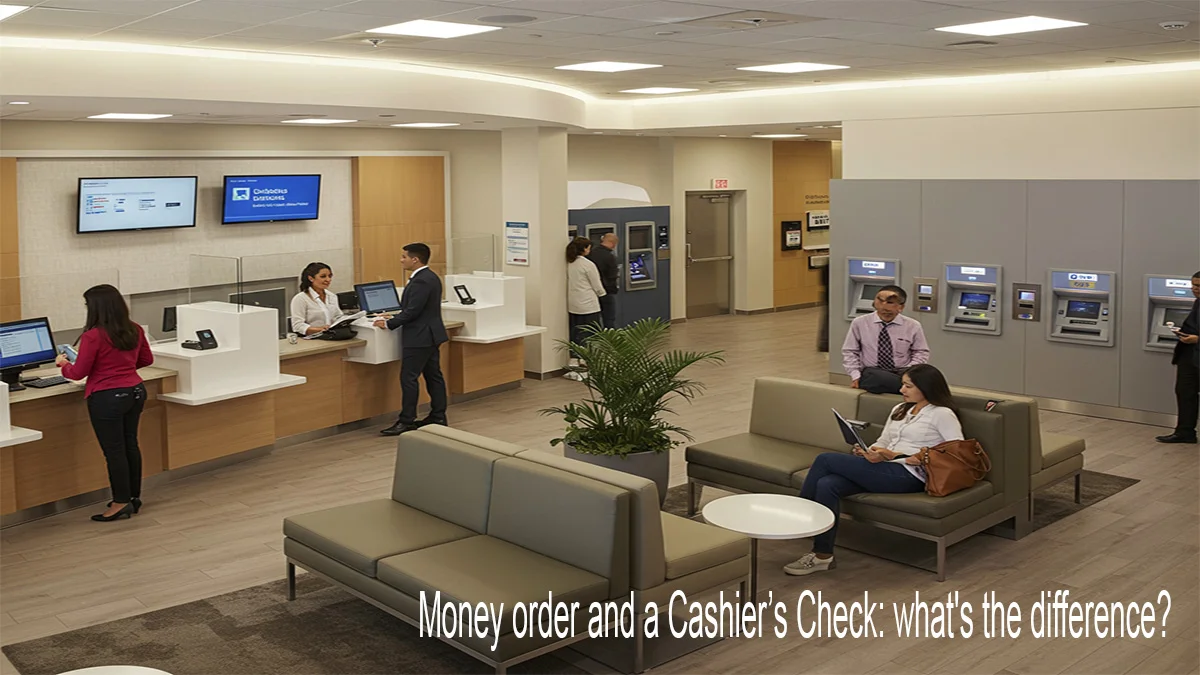Money order and a Cashier’s Check: what’s the difference?

When it comes to secure payment methods, two options often come to mind: money orders and cashier’s checks. Both serve as reliable alternatives to cash and personal checks, but they have distinct characteristics that can influence your choice. Whether you’re paying for a service, sending money across the country, or making a significant purchase, understanding these differences is crucial. Let’s dive into the details!
Understanding Money Orders
What is a Money Order?
A money order is a prepaid payment instrument that you can purchase from various locations, including post offices, grocery stores, and convenience stores. Essentially, when you buy a money order, you pay the amount upfront along with a small fee, and in return, you receive a document that indicates the specified amount of money.
Key Features of Money Orders:
- Accessibility: Money orders are widely available and can be purchased without needing a bank account.
- Limits: Most money orders have a limit of around $1,000. This means if you need to send more than that amount, you’ll have to purchase multiple money orders.
- Security: They are safer than cash since they are traceable; if lost or stolen, they can usually be canceled or replaced.
When to Use a Money Order
Money orders are ideal for smaller transactions or situations where you don’t have access to a bank account. They’re commonly used for:
- Paying rent
- Sending remittances
- Making purchases where personal checks aren’t accepted
Exploring Cashier’s Checks
What is a Cashier’s Check?
A cashier’s check is issued by a bank on behalf of the buyer and draws funds directly from the bank’s own funds rather than the individual’s account. This makes cashier’s checks particularly trustworthy because they guarantee payment.
Key Features of Cashier’s Checks:
- Trustworthiness: Because they are backed by the bank itself, cashier’s checks are often considered more reliable than personal checks.
- Higher Limits: Unlike money orders, there is typically no upper limit on the amount you can write on a cashier’s check (though banks may have their own policies).
- Bank Account Requirement: You generally need an account with the issuing bank to obtain a cashier’s check.
When to Use a Cashier’s Check
Cashier’s checks are perfect for larger transactions or when dealing with high-value purchases such as:
- Buying a car
- Real estate transactions
- Any situation requiring secure payment assurances
Key Differences Between Money Orders and Cashier’s Checks
Now that we’ve explored each payment method individually let’s break down their differences in a clear comparison:
| Feature | Money Orders | Cashier’s Checks |
|---|---|---|
| Availability | Widely available at various locations | Issued primarily by banks |
| Payment Limits | Typically capped at $1,000 | Usually no limit on amount |
| Need for Bank Account | No bank account required | Generally requires an account |
| Security Level | Secure but less trusted than cashier’s checks | Highly trusted due to bank backing |
| Fees | Generally lower fees | May incur higher fees |
What’s the difference between a Money Order and a Cashier’s Check?
The classic methods of secure payments, like money orders and cashier’s checks, often get overlooked. But wait! These traditional forms of payment have a lot to offer. Whether you’re making a big purchase, paying rent, or sending money to someone you trust, understanding these payment methods can give you peace of mind. Let’s dive into the fascinating world of money orders and cashier’s checks and discover why they remain valuable tools in our financial toolkit!
What Is a Money Order? Your Ultimate Guide to Secure Payments
In today’s fast-paced world, finding the right way to make payments can be a challenge. Have you ever found yourself in a situation where cash just isn’t secure enough, and your personal checks feel a little too risky? Enter the money order—your new best friend in the realm of safe transactions! This article will dive into what a money order is, how it works, and why you might want to consider using one for your next purchase.
What Exactly Is a Money Order?
A money order is a reliable paper payment method that allows you to pay for goods or services without having to carry cash or write a personal check. Think of it as a guaranteed form of payment! Typically available for amounts up to $1,000, money orders are an excellent option when you need something more secure than cash but don’t have access to traditional banking methods.
You can purchase money orders at various places like post offices, major retailers, grocery stores, and even convenience stores. They’re easy to obtain and usually come with only a small fee—making them an accessible choice for everyone!
How Do Money Orders Work?
Using a money order is straightforward! Here’s how it typically works:
- Purchase: When you decide to buy a money order, simply head to one of the mentioned locations. Make sure you have enough cash on hand—not just for the amount of the money order but also for any associated fees.
- Fill It Out: At the time of purchase, you’ll fill out the recipient’s name and sign the money order. This ensures that only the designated person can cash or deposit it.
- Keep Your Receipt: Once you’ve completed the transaction, hold onto your receipt! This serves as proof of payment and may come in handy if there are any issues later on.
- Delivery: Now it’s time for you to deliver it! The recipient can then cash or deposit the money order at their bank or financial institution.
Benefits of Using Money Orders
Money orders offer several advantages that make them an appealing choice:
- Security: Unlike cash, if lost or stolen, many issuers allow you to cancel and replace your money order (though fees may apply).
- No Bank Account Required: You don’t need a bank account to buy one; just bring cash!
- Widely Accepted: Many businesses accept money orders as they offer guaranteed funds.
- Budget-Friendly: With typical fees ranging from just a few dollars, they’re an affordable option compared to other payment methods.
When Should You Use a Money Order?
So when exactly should you consider using a money order? Here are some scenarios where they shine:
- Paying Rent: Many landlords prefer secure payments over personal checks.
- Online Purchases: If you’re buying from someone who doesn’t accept credit cards or prefers not to deal with electronic payments.
- Gifts or Donations: Sending gifts or donations can be safer with a money order rather than cash through the mail.
- Avoiding Check Holds: With checks taking time to clear, using a money order gives instant assurance that funds are available.
What Is a Cashier’s Check?
When it comes to making large payments, security is key! Enter the cashier’s check—a reliable, trustworthy method that’s perfect for those big-ticket items. If you’ve ever wondered what a cashier’s check is or how it works, you’re in the right place!
What Exactly Is a Cashier’s Check?
A cashier’s check, often referred to as a bank check, is a specialized payment tool that you can purchase at your bank or credit union. Unlike personal checks, which can bounce if there aren’t enough funds in your account, cashier’s checks are guaranteed by the bank. This means that they’re backed by real money—the bank’s money—making them a more secure option for high-value transactions.
To obtain a cashier’s check, you typically need to pay with cash or have sufficient funds in your bank account. The catch? Banks usually charge a small fee—generally between $10 and $20—for this service. But don’t worry! When you consider the peace of mind it offers, that fee might just feel like a bargain!
Why Use a Cashier’s Check?
Cashier’s checks come with several perks that make them ideal for significant payments:
1. Enhanced Security
Because they are backed by the bank, cashier’s checks are significantly more secure than money orders or personal checks. They reduce the risk of fraud and ensure that your payment is received without any hiccups.
2. Larger Amounts Allowed
Unlike money orders—which cap out around $1,000—cashier’s checks can be issued for any amount! Whether you’re purchasing a car, settling a hefty bill, or making an investment, cashier’s checks can handle it all.
3. Trustworthiness
A cashier’s check is typically made out to the intended recipient and signed by two bank representatives. This added layer of verification boosts confidence in the transaction.
4. Immediate Fund Availability
When you buy a cashier’s check using funds from your account, those funds are usually deducted immediately (unless specified otherwise). If you’re paying in cash, you’re ready to roll without delays!
How Do You Get One?
Ready to get started? Here’s how you can obtain a cashier’s check:
- Visit Your Bank: Head over to your local branch of your bank or credit union.
- Bring Identification: Ensure you have valid ID and any necessary information about who the check should be made out to.
- Pay for Your Check: Decide on the amount and be prepared to cover both the cost of the check and any associated fees.
- Receive Your Check: Once processed, you’ll receive your shiny new cashier’s check—ready for use!
Cautions to Keep in Mind
While cashier’s checks are fabulous tools for secure transactions, it’s crucial to remain vigilant:
- Scams Exist: Be cautious when receiving cashier’s checks from unknown sources; some scams involve counterfeit checks.
- Hold Periods: Some banks might place holds on these checks until they clear fully—be sure to ask about this when making your purchase!
When to Use a Money Order
Are you looking for a safe, reliable way to send money without the hassle of cash or personal checks? If so, you’re in the right place! Money orders are an excellent alternative that offers immediate access to funds while providing peace of mind for both the sender and recipient. In this article, we’ll explore when and why you should consider using a money order, making it easier than ever to decide if it’s the right option for your needs!
Why Choose a Money Order?
1. Immediate Access to Funds
One of the biggest advantages of using a money order is that it provides the recipient with immediate access to funds. Once they receive the money order, they can cash it or deposit it into their bank account right away! This feature makes money orders perfect for urgent payments where timing is crucial—like paying rent on time or settling a bill.
2. Enhanced Security
When you fill out a money order, you create an official record by signing it and designating the recipient. This added layer of documentation not only protects you but also ensures that the intended person receives the funds. In contrast, sending cash through the mail can lead to losses and no recourse if something goes wrong.
3. Ideal for Large Purchases
While many people think of money orders as small payment tools, they can also be useful for larger transactions! Just keep in mind that most money orders have a limit (often around $1,000). If your purchase exceeds this limit, you can always use multiple money orders to cover the total amount.
4. Convenient for Bill Payments
Whether you’re paying utilities, rent, or any other bills, using a money order can simplify your life! Many service providers accept money orders as valid payment methods. Just remember to keep your receipt as proof of payment—you never know when you’ll need it!
5. Making Official Payments
If you’re dealing with government agencies or other organizations that require secure forms of payment (like taxes or court fees), money orders shine in these situations! Their formal nature provides assurance to both parties involved that the payment has been made securely.
Tips for Using Money Orders
- Keep Track: Always retain your receipt until you’re sure the recipient has cashed or deposited the money order.
- Fill It Out Carefully: Make sure all information is accurate before sending it off—mistakes can cause delays!
- Consider Fees: While generally low-cost compared to wire transfers, remember there may be fees associated with purchasing a money order.
- Know Your Limits: Familiarize yourself with any limits set by the issuer so you don’t get caught off guard during larger transactions.
When to Use a Cashier’s Check: Your Go-To Guide for Secure Payments!
Have you ever found yourself in need of a reliable payment method for significant transactions? Whether you’re buying a car, closing on a new home, or securing an apartment, cashier’s checks are often the unsung heroes of large purchases!
When Should You Use a Cashier’s Check?
1. Large Purchases
Cashier’s checks are particularly useful for larger transactions where you need guaranteed funds. Here are some common scenarios:
- Buying a Vehicle: Whether you’re purchasing from a dealership or an individual seller, using a cashier’s check shows that you’re serious and have the necessary funds.
- Home Buying: If you’re closing on a house, you’ll likely need to pay closing costs with a cashier’s check. It provides peace of mind for both parties involved.
- Renting an Apartment: Landlords often require upfront payments like first month’s rent and security deposits. Using a cashier’s check can simplify this process.
2. When Security Matters
Cashier’s checks are one of the safest payment options out there! Since they’re issued by banks, they’re less likely to bounce compared to personal checks. If you’re making substantial payments, especially to individuals or businesses you may not know well, opting for a cashier’s check is wise.
3. Clearing Transactions Quickly
Another advantage of cashier’s checks is their speed in clearing once deposited. Unlike personal checks that might take several days to process, cashier’s checks typically clear quickly—allowing both parties to finalize their transactions sooner rather than later.
How Much Does It Cost?
While cashier’s checks usually come at a slightly higher cost than money orders (often around $10–$20), they have no set limit on the amount you can purchase. This makes them ideal for those hefty transactions where money orders simply won’t cut it!
How to Get One
Getting your hands on a cashier’s check is relatively straightforward:
- Visit Your Bank or Credit Union: Most financial institutions will issue one on the spot if you have an account with them.
- Online Options: Some banks now allow customers to order cashier’s checks online—check with your institution to see if this is available!
- Bring Identification and Funds: Make sure you have valid ID and enough funds in your account since the amount will be deducted immediately.
Keep Communication Open
Before rushing out to grab your cashier’s check, always double-check with the recipient about their preferred payment method. Some sellers might prefer wire transfers or other forms of payment; ensuring alignment will save you time and hassle!
Conclusion
Understanding the differences between money orders and cashier’s checks allows you to choose the right method based on your needs. While both options offer security and convenience over cash or personal checks, your specific transaction circumstances will dictate which one is best.
So next time you’re faced with making a significant payment or sending money securely, consider whether a money order or cashier’s check fits your situation better! With this knowledge in hand, you’re now ready to make informed financial decisions confidently! Happy transacting. Best regards, Finance Mate Club





